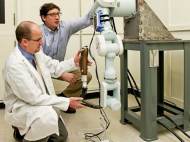ORNL researchers developing tech to improve prosthesis fitting and design
 Oak Ridge National Laboratory biomedical engineers are perfecting a portable, wearable system to measure walking patterns that can be applied to real-world activities in a variety of settings. They are also developing a low-cost gait analysis system that can be used to analyze whether prosthesis fits the wearer, or if it is aligned correctly without the need for a confined laboratory setting.
Oak Ridge National Laboratory biomedical engineers are perfecting a portable, wearable system to measure walking patterns that can be applied to real-world activities in a variety of settings. They are also developing a low-cost gait analysis system that can be used to analyze whether prosthesis fits the wearer, or if it is aligned correctly without the need for a confined laboratory setting.
“The goal of our research is to use the recent advances made in video game technology to develop inexpensive tools for amputee rehabilitation”, said Boyd Evans, who leads the project. “This will allow advanced rehabilitation techniques to both be used in smaller clinics and to be taken outside the clinic.”
Evans and his colleague John Mueller are collaborating with Brooke Army Medical Center in order to record the gait data. They are using inertial measurement units and other sensors that can be strapped onto different areas of a subject’s leg in order to monitor the motion and force of walking patterns. The data collected from the inertial measurement units is processed by algorithms which calculate the motions and forces associated with specific joints.
Cassee Cain and Ziyuan Liu, summer interns who worked with Evans and Mueller, worked on a subset of this project named Using Kinect for Xbox 360 and Computer Vision to Analyze Human Gait, and they won the Siemens Competition for Math, Science and Technology in early December. Their project involves the usage of multi-camera Kinect which is connected to a computer used to process the data with body-tracking algorithms to measure how different parts of the leg move when someone’s walking.
“We have high expectations for this system once it is fully developed”, said Mueller. “We think it will improve the prosthetic fitting and aligning process and help lower the risk of chronic joint disease in this group of wounded warriors.”
To test the effectiveness of measurements, the researchers use a robot leg, which has been programmed with data from a walking person. Evans and Mueller plan on going to the Gait and Motion Analysis Laboratory at Center for the Intrepid in a few months to test their system on a human subject with a prosthetic and healthy leg.
ORNL researcher Randy Lind is developing an advanced platform to measure the forces associated with motion, and researchers Nance Ericson and Ethan Farquhar are integrating the entire system to incorporate wireless data collection.
Aside increasing portability and lowering the costs, the system could be used to determine if the prosthesis is not fit or aligned correctly. Such prosthesis could affect a patient’s walking patterns, resulting in “asymmetric” gait which may lead to problems in the long term due to increased stress on the healthy limb.









Leave your response!